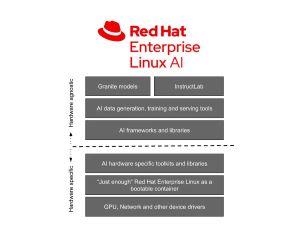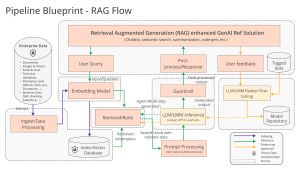News
Advanced AI Surges on Linux
While Linux is the OS of choice for many AI researchers and practitioners, Windows has been getting a lot more Gen AI functionality thanks to Microsoft's huge investment into OpenAI, but there are signs of an AI surge in the open-source OS space.
That surge has a ways to go, though, before it matches the AI friendliness of Windows, which was just exemplified by a "Wave 2" of Microsoft Copilot functionality (see yesterday's article, "AI Agents at Forefront of Microsoft's Copilot Vision"). Microsoft started early to infuse advanced AI Copilots throughout its products and services, including its flagship Windows OS, and that effort is just continuing.
The reason Linux is the darling of the data science/AI crowd stems from several factors, including:
- Customization and Performance: Linux allows developers to customize the OS at every level, optimizing resource allocation and system performance for specific AI workloads. This level of control is unmatched by proprietary systems, making Linux the go-to OS for GPU-accelerated tasks, such as training deep learning models.
- Cloud and Supercomputing Integration: Most cloud AI services, including Google Cloud, AWS, and IBM Cloud, are built on Linux infrastructure. The ease of deploying AI models on cloud-native Linux environments has solidified Linux's role in enterprise AI at scale. Additionally, Linux dominates supercomputers, making it the preferred choice for large-scale research projects that rely on advanced AI.
- Open-Source Ecosystem: Linux fosters a strong open-source community, allowing for rapid innovation in AI. Popular AI frameworks like TensorFlow and PyTorch were initially developed with Linux as the primary OS in mind, and they continue to see the best support and performance in Linux environments.
With those advantages, it seems Linux would have the upper hand in providing users with advanced AI, but that hasn't been the case so far. As one independent OS vendor, Microsoft might have a built-in advantage in the adoption of new technology over the scattered Linux distro space, but the open-source community appears to be catching up.
The best example of that is last week's general availability of Red Hat Enterprise Linux AI (RHEL AI), a platform designed to support enterprise AI innovation across hybrid cloud environments.
 [Click on image for larger view.] Red Hat Enterprise Linux AI (source: Red Hat).
[Click on image for larger view.] Red Hat Enterprise Linux AI (source: Red Hat).
"For GenAI applications to be truly successful in the enterprise, they need to be made more accessible to a broader set of organizations and users and more applicable to specific business use cases," said Red Hat exec Joe Fernandes in a statement. "RHEL AI provides the ability for domain experts, not just data scientists, to contribute to a built-for-purpose gen AI model across the hybrid cloud, while also enabling IT organizations to scale these models for production through Red Hat OpenShift AI" (see "Red Hat Enterprise Linux AI Goes GA").
But there has been recent movement across many other fronts recently, too. Here's a look.
Deepin 23
Just last month, the China-based Deepin 23 release debuted with "deep integration of AI capabilities, the launch of UOS AI Assistant and other AI applications."
 [Click on image for larger view.] Deepin 23 (source: Deepin Technology).
[Click on image for larger view.] Deepin 23 (source: Deepin Technology).
Accompanying release notes for the offering (UOS stands for Unity Operating System) state: "The system has integrated the latest UOS AI client, connecting to mainstream AI large model interfaces both domestically and internationally. Users can quickly set up their AI accounts to interact with large models through question-and-answer sessions. In addition, UOS AI also provides AI extension support for system-developed applications like image viewing, email, and global search based on local AI models, making daily use more efficient and convenient for users."
MakuluLinux
This family of distros is headed by Jacque Montague Raymer, who last month noted the upcoming release of MakuluLinux X, chock full of AI functionality. That release joins MakuluLinux Max, described as "the first of its kind, an AI Integrated Operating system."
"What makes the operating system unique is not only all the amazing theming and appearance features, instead its the Artificial Integration options that really stand out," the beta 2 release notes say. "You can communicate with AI using Voice, Widgets, Text, Web and Terminal interface, making it remarkably easy for anyone to communicate in their own preferred comfortable method, Not only to communicate with the AI, but you can control most of you computer just using your voice. To top that, the operating system also comes with a whole bunch of custom written AI applications, created by MakuluLinux to give that extra unique experience."
The distro family also includes MakuluLinux LinDoz, which the organization said "is built on our new hybrid 2023 Ubuntu/A.I driven Base and Designed on a heavily modified Cinnamon Framework," and Electra AI, an advanced AI assistant integrated into the MakuluLinux OS, which fosters the creation of images, videos and more.
Wind River eLxr Pro
The newest AI-powered Linux distro on the block is eLxr Pro from Wind River, just announced today.
 [Click on image for larger view.] eLxr Pro (source: Wind River).
[Click on image for larger view.] eLxr Pro (source: Wind River).
It's another offering for the "intelligent edge," this commercial enterprise Linux offering is said to address the unique needs of cloud-to-edge deployments, helped by AI.
"eLxr Pro enables organizations challenged with high-performance edge and enterprise needs to meet stringent performance and operational requirements for the next generation of commercial deployments across a wide range of emerging use cases for autonomous vehicles, aerospace, defense, energy, finance, medical, industrial automation, smart cities, and telecommunications," Wind River said. "It addresses the challenges of optimizing and deploying near and far edge applications to process data closer to where it is generated, for workloads that involve remote automatic updates, containerized applications and orchestration, AI inference, machine learning, and autonomous operations. eLxr Pro is based on the open source Debian-based eLxr project, an enterprise-grade distribution powering deployments for intelligent edge, far edge device, near edge server, regional data center, and public cloud scenarios."
Open Platform for Enterprise AI (OPEA)
While not a distro, this offering from The Linux Foundation helps organizations "efficiently integrate secure, performant, and cost-effective Generative AI workflows into business value."
According to its site, the OPEA platform includes:
- Detailed framework of composable building blocks for state-of-the-art generative AI systems including LLMs, data stores, and prompt engines
- Architectural blueprints of retrieval-augmented generative AI component stack structure and end-to-end workflows
 [Click on image for larger view.] Addressing RAG (source: LF AI & Data Foundation).
[Click on image for larger view.] Addressing RAG (source: LF AI & Data Foundation).
- A four-step assessment for grading generative AI systems around performance, features, trustworthiness and enterprise-grade readiness
More on that offering can be found in the article, "New Open Source AI & Data Platform Aims to Democratize GenAI Tech."
While these are just a few recent developments that serve to illustrate how open-source Linux is catching up to Windows in the AI space, things are advancing rapidly, so stay tuned for more updates.
About the Author
David Ramel is an editor and writer at Converge 360.